I am fortunate enough to live close to a large park in which, amongst other things, there is a lake with several varieties of aquatic birds – geese, swans and ducks. The lake itself is very pretty but not very big. The geese love to come up to the road to be fed and have a wander around, the other birds less so. Watching them is a lovely way to spend a sunny afternoon and it made me wonder about their lifestyles and what they eat.

Birds in the Park
by Telesto
I live near a park which has a few different species of aquatic birds. It's lovely to walk along and watch what they are up to - feeding, chatting, and swimming.
I am fortunate enough to live close to a large park in which there is a lake. A lake in which a variety of water fowl live. Swans, geese and ducks mainly. It's a big park, for Greater London, at 58 hectares in size.
The lake is actually only a small part of the park; there are also children’s playgrounds, a skate board park, tennis courts, football pitches and a bowling green, as well a designed garden area and part of it that is a bit more on the wild side.
When I walk to work in the mornings - most mornings - the geese are feeding near to the the road, and this is what I really love about the park. Seeing them there started me thinking about what these birds live on and their life style.
As well as swans and ducks, there are two types of goose that live here - Canada Geese and Greylag Geese. I hadn't realised, until I started to research and write this that they eat grass, although I suspect that the reason they wander so far is on the off chance that some human will feed them.
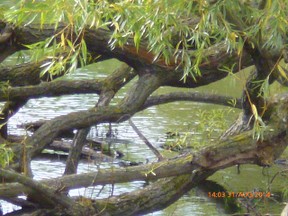
The Greylag Goose
The Greylag is quite an ancient bird, in evolutionary terms, being the ancestor to most, if not all, species of domesticated geese in Europe and North America. It’s the largest of the grey geese, with a thick, long neck and a large head. It has pink feet and legs and an orange (sometimes pink) bill. The male is generally larger than the female. They generally weigh between 4.5lbs to 10lbs and have a wingspan of between 58 to 70 inches.
The Greylag is still assumed to be a migratory bird, flying south in the winter – they tend to be one of the last to go, hence the term “lag” in the name – although, to be honest, I haven’t seen noticed them leaving in the last couple of years. I’ll make a special effort to watch out this year.
Greylags tend to feed on grass but will eat grains if available.
The Canada Goose
Canada Geese are quite large geese, and have black heads and necks. They have a sort of white chinstrap under their throats and around their necks. They originally came from North America. They are generally considered to be a bit of a nuisance because they can damage farmland and they beg for food. (I can testify to that!)
Canada geese are mainly herbivores, and eat grasses by tearing the blade of grass and jerking their head up. They also eat grains if available. They will eat small insects and fish too, and also feed from the silt at the bottom of the water, as well as aquatic plants. They will eat bread and whatever else people feed them, and have been known to take food out of rubbish bins.
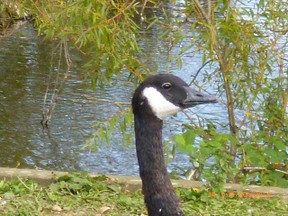
Mallards and Swans
Mallards
As with many bird species, the male mallard (the drake) is the colourful one, with its distinctive green head, although I have seen them with blue heads. The female is quite plain by comparison. They feed on grasses and insects, but tend to stay closer to the water in the park than the geese do.
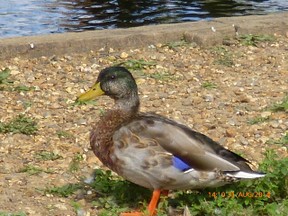
Swans
In the Northern Hemisphere, swans are white when fully grown, although as we know from the song, they start out life as a brownish-grey colour. (In the Southern Hemisphere they can be black and white, or completely black.) Watching them take off and land is an amazing sight, especially when they do it in formation. They use their webbed feet as brakes when they come in to land. Fascinating to watch! Typically, they eat grasses, algae and insects, but will also take food from humans. Please note: children love feeding these birds stale bread but do make sure that they keep their hands away from the beak, the birds don’t intend to hurt, but they can hurt a little hand if a mistake is made.
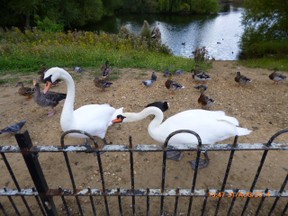
 | Ducks, Geese, and Swans of North America Ducks, Geese, and Swans of North America has been hailed as a classic since the first edition was published in 1942. A must-have for professional biologists, birders, waterfowl ... |
 | Flambeau 5889LO Floating Swan, 1-Pack The White Swan is a perfect addition to your pond or yard. Use for decor or to deter Canada Geese more economically and without all the costs, hazards, and time required when sp... |
You might also like
Swimming with Adélie PenguinsAdélie penguins might not be the most popular of the penguins, but they sure ...
The Fascinating World of Birds and Secrets of Bird WatchingThere is so much to explore from the fascinating world of birds which are uni...
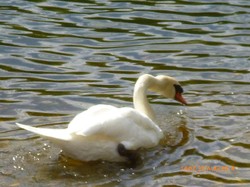




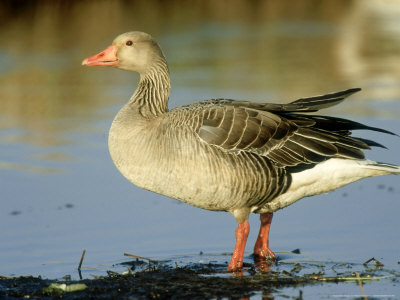

 Identity Theft and How it Feelson 02/01/2015
Identity Theft and How it Feelson 02/01/2015
 Barts Hospital - a National Treasureon 01/24/2015
Barts Hospital - a National Treasureon 01/24/2015
 Urban Foxeson 01/11/2015
Urban Foxeson 01/11/2015
 How do you know which hosting platform to choose?on 01/03/2015
How do you know which hosting platform to choose?on 01/03/2015

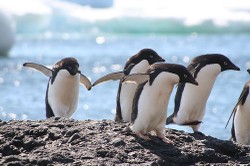
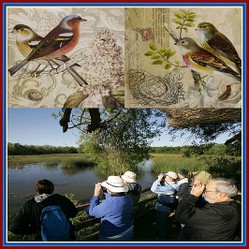
Comments
Thank you MBC, appreciated. And yes, I am very lucky.
Lucky you - living so close to this park. I live in Colorado where we have a large population of Canadian Geese. They frequent any outdoor fountain. And they stay here all winter usually. Loved this article.
Thank you, I had a great afternoon out snapping away, and I got chatting to some lovely people. My favourite Central London Parks are Regent's Park and St James' Park.
That sounds fantastic. But cold...
This looks like a lovely park. The one time I was in London was not long enough to check out all these hidden treasures. I like your photos of these birds.
Our little home is on a lake, and we enjoy most of the birds you have shared. Lately there have been the birds that like to dive under water, I forget what they are called. They are usually very busy and lively on the lake, but soon it will freeze over, and the birds will be gone for a while. I'll miss them.
I think I'm just nosey! Seriously, they get fed by lots of people passing by and it made me wonder how they manage if humans stop feeding them. Thank you for reading.
Yes, I am very lucky WriterArtist, thank you for reading.
Telesto, Water birds have a special gracefulness to their flight. In childhood there was a sunken gardens that my family visited often; I loved the beautiful swans.
Canada Geese frequently fly overhead here. Their honking is distinctive. Sometimes they honk loudly and other times their conversations are almost hushed.
Your photos capture the beauty of these birds. It's fun that you were inspired to sleuth their dietary habits.
I love birds but unfortunately with urbanization the city in which I live is full of people, concrete and smoke. There are small green patches here and there, I love to sneak for some respite. I am glad that you can enjoy this beautiful green space full of birds. I am fond of bird watching too - it is a wonderful experience.